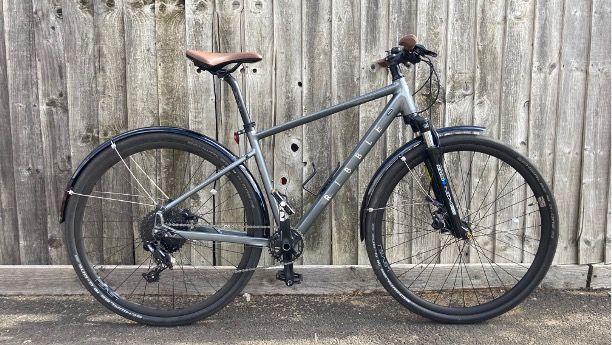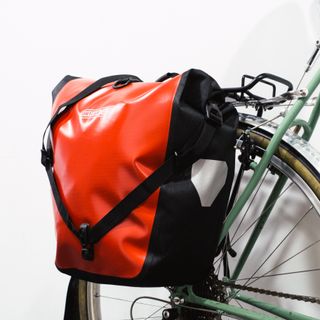What is a hybrid bike? Everything you need to know
All the features you’ll find on a hybrid bike for road and light off-road riding

If you’re looking for a bike for leisure riding or for commuting, chances are you’re looking at a hybrid bike.
Hybrid bikes are designed to be ridden predominantly on-road, but incorporate some features from mountain bikes. This is where the 'hybrid' name comes from.
They have flat bars, rather than the drop bars typical of most types of road bike. They also usually have wider tyres than most road bikes.
Many hybrid bikes are used for all-weather commuting, so they’ll often include mudguards, while some hybrid bikes will also be sold with integrated bike lights. A rear rack is useful, whether to carry items into work or for extras for a leisure ride.
Below, we’ll run through the typical features of a hybrid bike, then some optional features that you may want to consider if you’re looking for the best one for your own needs.
Typical features of a hybrid bike
There are some attributes that are common to almost all hybrid bikes, which we’ll run through first. There are additional features that we’ll run through later that some, but not all, hybrid bikes will include, which may be nice to have for some potential hybrid bike buyers.
Lower price
You can trust Cyclingnews

As a general rule, hybrids are typically among the lowest-priced bikes to buy new. They’re less expensive than many road bikes and less complex, and so less expensive than the majority of mountain bikes.
There are exceptions though, as the best budget road bikes may undercut the price of some more premium hybrids, for example.
You can also find some expensive hybrids with a carbon frame and high-spec gearing, so don’t assume a hybrid bike is always going to be the cheapest option!
Flat bars

Hybrid bikes have flat bars, rather than the drop bars found on most types of road bike. Flat bars are much easier for novice and occasional riders to use, as the brakes and gear selectors are right next to the handlebar grips and easy to access.
They also place the rider in a more upright ride position that’s more comfortable than being leant over a road bike’s drop bars. They're wider and so offer greater control.
The main disadvantages are that your hands and arms only have one position available, which can get tiring. You also can’t easily reduce your frontal profile, so it’s more difficult to ride fast or battle a headwind than with a race bike.
Upright ride position

It’s not just the flat bars that promote an upright ride position. The bike’s geometry normally gives a short reach to the bars and a long head tube, so that the majority of the rider’s weight is resting on the saddle, not the handlebars.
The more upright position may make it easier for you to see around you and to look behind.
Low standover frame

Hybrid bike frames are also usually designed to make it easy to get on and off the bike and to put a foot down when coming to a stop.
A hybrid bike frame will often have a top tube, although this may slope to allow the rider to mount the bike more easily and provide easy stand-over. Other hybrid bikes have a frame without a top tube. These were historically aimed at women but can make it easier for all genders to get on and off. There are also mixte frames, which have a sloping top tube and provide an intermediate step-over design.
Many hybrid bike frames are made of aluminium alloy. It’s lightweight, doesn’t rust, is durable and is relatively inexpensive. A premium hybrid bike, such as the Specialized Sirrus 6.0, may be made of carbon fibre. A steel frame is also an option, as seen in Decathlon’s Riverside 120.
Comfort-oriented saddle

With much of the rider’s weight on the saddle, a hybrid bike will usually have one that’s much more padded than that on a road bike. The saddle is also likely to be wider, as you’re sitting on a wider part of your sitbones.
Don’t assume that a deeply padded saddle will be the most comfortable though. Too much padding means that you sink into the saddle, which can cause rubbing and become uncomfortably hot.
Wider tyres with treads

While road bike tyres are typically 32mm or narrower, hybrid bike tyres are more likely to be around 40mm wide. This allows you to run them at lower pressures, adding some extra insulation from the road surface. They also typically have a tread, while road bike tyres have minimal tread or are slick.
Many hybrid bike tyres also have reflective sidewalls, helping to add visibility when riding at night, which can be particularly valuable for commuters.
Wide-range gearing

The versatility of hybrid bikes is usually increased with wide gear ranges. Hybrid bikes will usually be lower geared than many road bikes, in line with the generally lower speeds at which they are ridden.
While new road bike groupsets typically have 12-speed drivetrains (the number of cogs in the cassette attached to the back wheel), many hybrid bikes are fitted with lower spec gear systems, often with 7, 8 or 9 speeds.
That may be paired with a triple chainring at the front, although double chainring or single chainring drivetrains are also common.
Some hybrid bikes are single-speed. Hub gears with 5, 8 or more gear ratios are also popular, as they’re low maintenance and weatherproof. In both cases, a belt drive is an increasingly common alternative to a chain, again cutting down on maintenance, as belt drives are lubricant-free, durable and don’t rust.
- Bike gears explained: A detailed guide on how they work
Flat pedals

While most bikes are supplied with flat pedals, road bike riders often switch to riding clipless pedals. Hybrid bike riders may fit double-sided clipless pedals, but many will stick with flats. For guidance on the benefits and pitfalls of either option, check out our guide to clipless vs flat pedals.
Flats are easier to get used to and they make stop-and-go riding in town easier, as it’s easier to put a foot down and to re-engage with the pedals when starting off. On the other hand, they may make your pedalling less efficient.
Mounting points

Hybrid bike frames are typically equipped with mounting points for mudguards and a rear rack. Many hybrid bikes come with both attached.
Mudguards make all-weather riding much more comfortable and so are useful for riders looking to commute by bike. A rear rack can be used for bike luggage, such as a rack bag or panniers, which again are useful for commuters, but also for leisure riding, shopping and other purposes.
Optional additional features
You’ll find the above features on almost all hybrid bikes. In addition, there are some items that you’ll only find on a subset of hybrids.
Lighting

Many hybrid bikes will be sold equipped with front and rear lights. If you intend to commute on your hybrid or use it for longer trips, lights are a handy extra. They may be battery-powered, but lights powered by a dynamo, typically housed in the front hub, are also an available option.
Suspension

It’s not uncommon to see a suspension fork fitted to a hybrid bike. It’s worth weighing up whether you need one though.
Many hybrid bike suspension forks are lower priced and typically use a coil spring and have relatively short travel, so they won’t give the same ride quality as a pricey MTB suspension fork. A suspension fork will also add weight to a bike and may require servicing that a rigid fork would avoid.
Much of the surface smoothing for a hybrid bike will come from the wide tyres, so a suspension fork may not be necessary.
Electric assistance

Along with electric mountain bikes, hybrid bikes are one of the most frequent bike classes to be sold with electric assistance. An electric motor adds versatility and makes tackling hills and carrying loads much easier.
Since hybrid bikes aren’t designed around fast riding, speeds are likely to be within the range within which a motor will provide a decent level of assistance and since they aren’t in general designed to be lightweight, a chunkier motor and battery are unlikely to be an issue.
Thus, electric hybrid bikes are in many cases among the least expensive budget electric bikes that can be bought.
Get The Leadout Newsletter
The latest race content, interviews, features, reviews and expert buying guides, direct to your inbox!
Paul has been on two wheels since he was in his teens and he's spent much of the time since writing about bikes and the associated tech. He's a road cyclist at heart but his adventurous curiosity means Paul has been riding gravel since well before it was cool, adapting his cyclo-cross bike to ride all-day off-road epics and putting road kit to the ultimate test along the way. Paul has contributed to Cyclingnews' tech coverage for a few years, helping to maintain the freshness of our buying guides and deals content, as well as writing a number of our voucher code pages.


